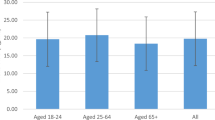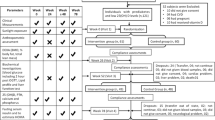Abstract
Background/Objectives:
Based on the growing evidence of risk reduction from fresh fruit and vegetable consumption and an inverse relationship between serum 25-hydroxyvitamin D (25OHD) and the risk of type 2 diabetes (T2D), we determined the benefits of regularly consuming vitamin D-enriched mushrooms in a prediabetic cohort. Exposing edible mushrooms to ultraviolet B (UVB) light increases vitamin D2 (D2) and raises serum 25OHD2 in healthy young adults; however, their benefit to deficient prediabetics and glucose metabolism remains untested.
Subjects/methods:
Forty-three prediabetic, D-deficient adults (25OHD≤20 ng/ml), BMI>25 were randomized to four groups consuming daily entrées containing 100 g fresh sliced cooked mushrooms prepared by a chef for 16 weeks. Two groups were fed UVB-treated mushrooms initially containing: 600 IU D2 or 4000 IU D2; each one also received one capsule of placebo daily. Two control groups were fed untreated mushrooms and D3 dietary supplements at two label doses: 600 IU D3 and 4000 IU D3. D2 and D3 content were analyzed in mushrooms, before and after cooking and in over-the-counter supplements.
Results:
After 16 weeks, both D2-UVB-mushroom entrée doses, which were significantly lower after cooking, produced modest or no increases in 25OHD2 or total 25OHD relative to the positive control subjects who actually consumed about 1242 and 7320 IU per day of D3 (higher than stated on the label).
Conclusions:
Unanticipated D2 cooking loss from fresh UVB mushrooms and probable low absorption and/or hydroxylation may explain the smaller increase in 25OHD2 in our prediabetic overweight/obese cohort compared with past findings in younger, healthy subjects. Moreover, no dose or vitamin D source was associated with modifying T2D risk factors.
This is a preview of subscription content, access via your institution
Access options
Subscribe to this journal
Receive 12 print issues and online access
$259.00 per year
only $21.58 per issue
Buy this article
- Purchase on Springer Link
- Instant access to full article PDF
Prices may be subject to local taxes which are calculated during checkout


Similar content being viewed by others
References
Song Y, Wang L, Pittas AG, DelGobbo LC, Zhang C, Manson JE et al. Blood 25-hydroxyvitamin D levels and incident type 2 diabetes: a meta-analysis of prospective studies. Diabetes Care 2013; 36: 1422–1428.
Forouhi NG, Ye Z, Rickard AP, Khaw KT, Luben R, Langenberg C et al. Circulating 25-hydroxyvitamin D concentration and the risk of type 2 diabetes: results from the European Prospective Investigation into Cancer (EPIC)-Norfolk cohort and updated meta-analyses of prospective studies. Diabetologia 2012; 55: 2173–2182.
Boucher BJ . Is vitamin D status relevant to metabolic syndrome? Dermatoendocrinology 2012; 4: 212–224.
Fourouhi NG, Luan J, Cooper A, Boucher BJ, Wareham NJ . Baseline serum 25-hydroxyvitamin D is predictive of future glycemic status and insulin resistance: the Medical Research Council Ely Prospective Study 1990-2000. Diabetes 2008; 57: 2619–2625.
Lim S, Kim MJ, Choi SH, Shin CS, Park KS, Jang HC et al. Association of vitamin D deficiency with incidence of type 2 diabetes in high risk Asian subjects. Am J Clin Nutr 2013; 97: 524–530.
Knekt P, Laaksonen M, Mattila C, Harkanen T, Marniemi J, Heliovaara M et al. Serum vitamin D and subsequent occurrence of type 2 diabetes. Epidemiology 2008; 19: 666–671.
Liu E, Meigs JB, Pittas AG, Economos CD, McKeown NM, Booth SL et al. Predicted 25-hydroxyvitamin D score and incident type 2 diabetes in the Framingham Offspring Study. Am J Clin Nutr 2010; 91: 1627–1633.
Vacek JL, Vanga SR, Good M, Lai SM, Lakkireddy D, Howard PA et al. Vitamin D deficiency and supplementation and relation to cardiovascular health. Am J Cardiol 2012; 109: 359–356.
Jorde R, Sneve M, Hutchinson M, Emaus N, Figenschau Y, Grimes G et al. Tracking serum 25-hydroxyvitamin D levels during 14 years in a population-based study and during 12 months in an intervention study. Am J Epidemiol 2010; 171: 903–908.
Gagnon C, Lu ZY, Magliano JD, Dunstan DW, Shaw JF, Zimmet PZ et al. Serum 25-hydroxyvitamin D, calcium intake and risk of type 2 diabetes after 5 years: results from a national, population-based prospective study (The Australian Diabetes, Obesity and Lifestyle Study). Diabetes Care 2011; 34: 113–1138.
Abbas S, Linseisen J, Rohrmann S, Beulens JWS, Buijsse B, Amiano P et al. Dietary vitamin D intake and risk of type 2 diabetes in the European prospective investigation into cancer and nutrition: the Epic-InterAct Study. Eur J Clin Nutr 2014; 68: 1962–202.
Boucher BJ . The problems of vitamin D insufficiency in older people. Aging Dis 2012; 3: 313–329.
Hossein-nezhad A, Holick MF . Vitamin D for health: a global perspective. Mayo Clinic Proc 2013; 88: 720–755.
Boeing H, Bechthold A, Bub A, Ellinger S, Haller D, Kroke A et al. Critical review: vegetables and fruit in the prevention of chronic diseases. Eur J Nutr 2012; 51: 637–663.
Cooper AJ, Forouhi NG, Ye Z, Buijsse B, Arriola L, Balkau A et al. Fruit and vegetable intake and type 2 diabetes: Epic-InterAct Propsective study and meta-analysis. Eur J Clin Nutr 2012; 66: 1082–1092.
Folchetti LD, Monfort-Pires M, deBarros CR, Martini LA, Ferreira SRG . Association of fruits and vegetables consumption and related vitamins with inflammatory and oxidative stress markers in pre-diabetic individuals. Diabetol Metab Syndr 2014; 6: 22–30.
Kalaras MD, Beelman RB, Elias RS . Effects of post-harvest pulsed UV light treatment of white button mushrooms (Agaricus bisporus) on vitamin D2 content and quality attributes. J Agric Food Chem 2012; 60: 220–225.
Calvo MS, Babu US, Garthoff LH, Woods TO, Dreher M, Hill G et al. Vitamin D2 from light-exposed edible mushrooms is safe, bioavailable and effectively supports bone growth in rats. Osteoporos Int 2013; 24: 197–207.
Babu US, Balan KV, Garthoff LH, Calvo MS . Vitamin D2 from light exposed mushrooms modulates immune response to LPS in rodents. Mol Nutr Food Res. 2013; 58: 318–328.
Keegan R-JH, Lu Z, Bogusz JM, Williams JE, Holick MF . Photobiology of vitamin D in mushrooms and its bioavailability in humans. Dermatoendocrinology 2013; 5: 1–12.
Urbain P, Singler F, Ihorst G, Biesalski HK, Bertz H . Bioavailability of vitamin D(2) in healthy adults deficient in serum 25-hydroxyvitamin D: a randomized controlled trial. Eur J Clin Nutr 2011; 65: 965–971.
Stephensen CB, Zerofsky M, Burnett DJ, Lin YP, Hammock BD, Hall LM et al. Ergocalciferol from mushrooms or supplements consumed with a standard meal increases 25-hydroxyergocalciferol but decreases 25-hydroxycholecalciferol in serum of healthy adults. J Nutr 2012; 142: 1246–1252.
Jeong SC, Jeong YT, Yang BY, Rezuanul I, Koyyalamudi SR, Pang G et al. White button mushrooms (Agaricus Bisporus lowers blood glucose and cholesterol levels in diabetic and hypercholestrolemic rats. Nutr Res 2010; 30: 49–56.
Horvath K . Price gouging: spiraling diabetes-related costs demand redoubled prevention efforts. Endocrine News 2013; July: 17–18.
Borel P . Factors affecting intestinal absorption of highly lipophilic food micronutrients (fat-soluble vitamins, carotenoids and phytosterols). Clin Chem Lab Med 2003; 41: 979–994.
Peters JC, Lawson KD, Middleton SJ, Triebwasser KC . Assessment of the nutritonal effects of olestra, a nonabsorbed fat replacement: Summary. J Nutr 1997; 127: 1719S–1728S.
Van den Berg H, van der Gaag M, Hendricks H . Influence of lifestyle on vitamin D bioavailability. Int J Vitam Nutr Res 2002; 72: 53–59.
Takeuchi A, Okano T, Teraoka S, Murakami Y, Kobayashi T . High performance liquid chromatographic determination of vitamin D in foods, feed and pharmaceuticals by successive use of reversed-phase and straight-phase columns. J Nutr Sci Vitaminol (Tokyo) 1984; 30: 11–25.
Heaney RP, Recker RR, Grote J, Horst RL, Armas LA . Vitamin D3 is more potent than vitamin D2 in humans. J Clin Endocrinol Metab 2011; 96: E447–E452.
Tripkovic L, Lambert H, Hart K, Smith CP, Bucca G, Chope G et al. Comparison of vitamin D2 and vitamin D3 supplementation in raising serum 25-hydroxyvitamin D status: a systematic review and meta-analysis. Am J Clin Nutr 2012; 95: 1357–1364.
Biancuzzo RM, Clarke N, Reitz RE, Travison TG, Holick MF . Serum concentrations of 1,25-dihydroxyvitamin D3 in response to vitamin D2 and vitamin D3 supplementation. J Clin Endocrinol Metab 2013; 98: 973–979.
Hollis BW, Wagner CL . The role of the parent compound vitamin D with respect to metabolism and function: Why clinical dose intervals can affect clinical outcomes. J Clin Endocrinol Metab 2013; 98: 4619–4628.
Haddad Jr JG, Hahn TJ . Natural and synthetic sources of circulating 25-hydroxyvitamin D in man. Nature 1973; 244: 515–517.
Gallo S, Phan A, Vanstone CA, Rodd C, Weiler HA . The change in plasma 25-hydroxyvitamin D did not differ between breast-fed infants that received a daily supplement of ergocalciferol or cholecalciferol for 3 months. J Nutr 2013; 143: 148–153.
Fisk CM, Theobald HE, Sanders TA . Fortified malted milk drinks containing low-dose ergocalciferol and cholecalciferol do not differ in their capacity to raise serum 25-hydroxyvitamin D concentrations in healthy men and women not exposed to UVB. J Nutr 2012; 142: 1286–1290.
Roberts JS, Teichert A, McHugh TH . Vitamin D2 formation from post-harvest UV-B treatment of mushrooms (Agaricus bisporus) and retention during storage. J Agric Food Chem 2008; 56: 4541–4544.
LeBlanc ES, Perrin N, Johnson Jr JD, Ballatore A, Hiller T . Over-the-counter and compounded vitamin D: is potency what we expect? JAMA Intern Med 2013; 173: 585–586.
Batchelor AJ, Compston JE . Reduced plasma half-life of radio-labelled 25-hydroxyvitamin D3 in subjects receiving a high-fibre diet. Br J Nutr 1983; 49: 213–216.
Von Hurst PR, Stonehouse W, Coad J . Vitamin D Supplementation reduces insulin resistance in south Asian women living in New Zealand who are insulin resistant and vitamin D deficient-a randomized placebo-controlled trial. Br J Nutr 2010; 103: 549–555.
Acknowledgements
The Mushroom Council, the US FDA Center for Food Safety and Applied Nutrition, the Center for Plant and Mushroom Products for Health at the Penn State University, and the National Institutes of Health, National Institute of Research Resources (Grant M01-RR-00071) to the General Clinical Research Center at The Mount Sinai School of Medicine.
Disclaimer
The findings and conclusions presented in this manuscript are those of the authors and do not necessarily represent the views or opinions of the US Food and Drug Administration. The Mushroom Council did not participate in the study design, data collection, data analysis or manuscript preparation.
Author Contributions
JU, MSC and RBB designed the research; EL and JS conducted the research; AM and JU analyzed the data; MSC, JU and AM wrote the manuscript; MDK had editorial input; JU had primary responsibility for final content. All authors read and approved the final manuscript.
Author information
Authors and Affiliations
Corresponding author
Ethics declarations
Competing interests
The authors declare no conflict of interest.
Additional information
Supplementary Information accompanies this paper on European Journal of Clinical Nutrition website
Supplementary information
Rights and permissions
About this article
Cite this article
Mehrotra, A., Calvo, M., Beelman, R. et al. Bioavailability of vitamin D2 from enriched mushrooms in prediabetic adults: a randomized controlled trial. Eur J Clin Nutr 68, 1154–1160 (2014). https://doi.org/10.1038/ejcn.2014.157
Received:
Revised:
Accepted:
Published:
Issue Date:
DOI: https://doi.org/10.1038/ejcn.2014.157
This article is cited by
-
A novel antioxidant ergothioneine PET radioligand for in vivo imaging applications
Scientific Reports (2021)
-
Assessing the impact of a mushroom-derived food ingredient on vitamin D levels in healthy volunteers
Journal of the International Society of Sports Nutrition (2020)
-
Investigation of the vitamin D nutritional status in women with gestational diabetes mellitus in Beijing
Lipids in Health and Disease (2017)
-
Model-based meta-analysis for comparing Vitamin D2 and D3 parent-metabolite pharmacokinetics
Journal of Pharmacokinetics and Pharmacodynamics (2017)
-
A Retrospective Study in Adults with Metabolic Syndrome: Diabetic Risk Factor Response to Daily Consumption of Agaricus bisporus (White Button Mushrooms)
Plant Foods for Human Nutrition (2016)



